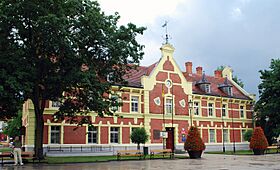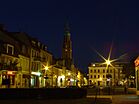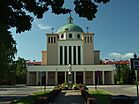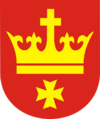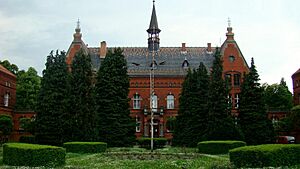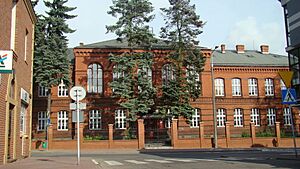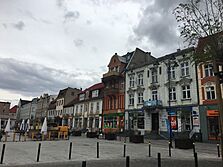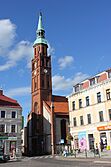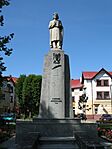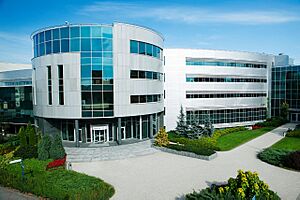Starogard Gdański facts for kids
Quick facts for kids
Starogard Gdański
|
|||
|---|---|---|---|
|
|||
|
|||
| Country | |||
| Voivodeship | |||
| County | Starogard | ||
| Gmina | Starogard Gdański (urban gmina) | ||
| Established | 1198 | ||
| City rights | 1348 | ||
| Area | |||
| • Total | 25.27 km2 (9.76 sq mi) | ||
| Population
(2020)
|
|||
| • Total | 47,272 | ||
| • Density | 1,870.7/km2 (4,845.0/sq mi) | ||
| Time zone | UTC+1 (CET) | ||
| • Summer (DST) | UTC+2 (CEST) | ||
| Postal code |
83-200
|
||
| Area code(s) | +48 58 | ||
| Car plates | GST | ||
| Website | http://www.starogard.pl | ||
Starogard Gdański is a city in northern Poland. It is located in the Pomeranian Voivodeship. The city has about 47,000 people living there.
Starogard Gdański is the main city of Starogard County. It is also the second largest city in the Kociewie region. This area is home to the Kociewians, a special ethnic group.
Contents
Where is Starogard Gdański?
Starogard Gdański is in a region called Pomerania. It sits on a small river named Wierzyca. The city is about 21 kilometers (13 miles) southwest of Tczew. It is also about 40 kilometers (25 miles) south of Gdańsk. The city is 50 kilometers (31 miles) from the Tricity area. This is a big group of cities on the coast of Gdańsk Bay.
What's in the Name?
The name Starogard means "old city" in the local Pomeranian language. The word Gdański was added in the 20th century. This was done to tell it apart from other places called Starogard. For example, the German name Preußisch Stargard (Prussian Stargard) was used for the same reason.
A Look Back in Time
Scientists have found signs of a very old settlement here. It dates back about four to five thousand years.
Early History of the City
In the 10th century, this area became part of the new Polish state. Later, in 1198, Starogard was first mentioned in writing. A local leader, Duke Grzymisław II of Pomerania, gave the settlement to the Knights Hospitaller. These were a group of knights who helped people.
In 1282, the region, including Starogard, became part of Poland again. But in 1308, the Teutonic Knights took control. They were a powerful group of knights from Germany. In 1348, Starogard was given city rights. This meant it could govern itself more.
Joining the Polish Kingdom
Starogard joined the Prussian Confederation in 1440. This group fought against the Teutonic Knights. In 1454, the Polish King Casimir IV Jagiellon made the region part of Poland again. The city agreed to be ruled by the King.
The Teutonic Knights took Starogard back in 1461. But Poland recaptured it in 1466. A peace treaty was signed, and Starogard officially became part of Poland. It stayed under Polish rule until 1772. Then, it became part of the Kingdom of Prussia. The city was called Preußisch Stargard by the Prussians. They also tried to make people speak German.
Modern Times Begin
In 1871, a large vodka factory was built in the city. It is still working today and makes famous brands like Sobieski. This factory is one of the oldest vodka makers in Europe. Also in 1871, the city got connected to the train network.
In 1906–1907, Polish children in the city went on school strikes. They were protesting against being forced to learn German.
After World War I, in 1920, Starogard became part of independent Poland again.
World War II and Its Impact
In September 1939, Nazi Germany invaded Poland, starting World War II. German forces entered Starogard. They arrested many Polish teachers, priests, and local leaders. These people were often treated very badly.
Near the city, in Szpęgawski Forest, about 7,000 Poles were killed by the Germans. This included many patients from the local psychiatric hospital in Kocborowo. About 500 children with disabilities were also killed at the hospital. Many hospital staff were killed or sent to forced labor camps. The Germans also set up a subcamp of the Stutthof concentration camp in the town.
Despite these terrible times, Poles in Starogard still fought back. They formed underground groups like the Home Army.
After the War
In 1945, the German occupation ended. Starogard was returned to Poland. However, a communist government was put in place by the Soviet Union. This government lasted until the 1980s.
In 1951, a 16-year-old girl named Teresa Block started an anti-communist group called Jord-Just. The group had 17 teenage members. They were later caught by the communists and sent to prison.
How Many People Live Here?
| Year | Number of People |
|---|---|
| 1772 | 1,103 |
| 1782 | 1,410 |
| 1831 | 3,145 |
| 1875 | 6,022 |
| 1880 | 6,253 |
| 1890 | 7,080 |
| 1905 | 10,485 |
| 1921 | 13,360 |
| 1943 | 17,895 |
| 1960 | 25,800 |
| 1970 | 33,700 |
| 1980 | 44,200 |
| 1990 | 49,500 |
| 2001 | 49,884 |
| 2012 | 49,072 |
Big Companies in Starogard Gdański
- Polpharma SA: A large pharmaceutical company that makes medicines.
- Destylarnia Sobieski SA: The vodka distillery mentioned earlier.
Getting Around the City
Major roads like Polish National Road 22 pass through the city. The A1 motorway is also nearby. Starogard Gdański also has a train station.
Learning in Starogard Gdański
The city has several schools and colleges:
- Pomorska Szkoła Wyższa w Starogardzie Gdańskim (Pomeranian University College)
- I Liceum Ogólnokształcące w Starogardzie Gdańskim (First General High School)
Sports in the City
Starogard Gdański has a well-known basketball team called SKS Starogard Gdański. They play in Poland's top league. They even won the Polish Basketball Cup in 2011!
The local football (soccer) club is KP Starogard Gdański. They play in green and white at the city stadium.
Famous Athletes from Starogard Gdański
- Kazimierz Deyna (1947–1989): A famous Polish football player. He won an Olympic Gold Medal and played in the World Cup. The city's stadium is named after him. There's even a statue and a special trail in the city about his life.
- Oktawia Nowacka (born 1991): An Olympic bronze medalist in modern pentathlon.
- Michael Hicks: An Olympian who plays 3x3 basketball for Poland. He lives in Starogard Gdański and runs basketball camps for young people.
Well-Known People from Starogard Gdański

- Adolf Lesser (1851–1926): A German doctor who studied forensic medicine.
- Adolf Wallenberg (1862–1949): A German doctor specializing in internal medicine and neurology.
- Theo Mackeben (1897–1953): A German pianist, conductor, and composer.
- Kazimierz Kropidłowski (1931–1998): A Polish long jumper who competed in the Olympics.
- Henryk Jankowski (1936–2010): A Polish Roman Catholic priest and part of the Solidarity movement.
- Władysław Wojtakajtis (1949–2016): A Polish swimmer who competed in the Olympics.
- Andrzej Grubba (1958–2005): A famous Polish table tennis player.
- Maria Kamrowska (born 1966): A retired Polish athlete who competed in heptathlon.
- Paweł Papke (born 1977): A retired Polish volleyball player.
- Piotr Wiśniewski (born 1982): A Polish football player.
Sister Cities
Starogard Gdański has special friendships with other cities around the world. These are called "sister cities":
See also
 In Spanish: Starogard Gdański para niños
In Spanish: Starogard Gdański para niños


